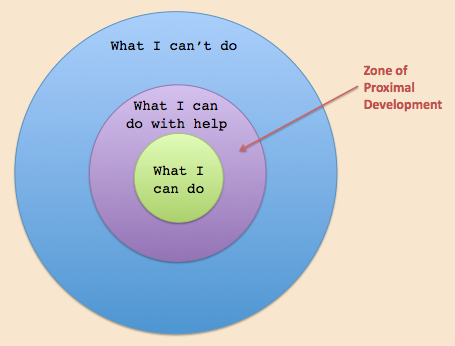Vygotsky’s Zone of Proximal Development
Inherent in scaffolded instruction is Lev Vygotsky’s (1978) idea of the zone of proximal development. Vygotsky suggests that there are two parts of a learner’s developmental level: the “actual developmental level” and the “potential developmental level”. The zone of proximal development is “the distance between the actual developmental level as determined by independent problem solving and the level of potential development as determined through problem solving under adult guidance, or in collaboration with more capable peers” (Vygotsky, 1978, p. 86).
The zone of proximal development (ZPD) can also be described as the area between what a learner can do by himself and that which can be attained with the help of a ‘more knowledgeable other’ adult or peer. The ‘more knowledgeable other’, or MKO, shares knowledge with the student to bridge the gap between what is known and what is not known. Once the student has expanded his knowledge, the actual developmental level has been expanded and the ZPD has shifted. The ZPD is always changing as the student expands and gains knowledge, so scaffolded instruction must constantly be individualized to address the changing ZPD of each student.

It was Vygotsky’s belief that “good learning” occurs in the child’s zone of proximal development. Important to teaching in the ZPD is the determination of what the student can manage on his own and to allow the student to do as much as possible without any assistance. “Fading” is the process of gradually removing the scaffolding that was put into place for the child until it is completely gone. Eventually, the child internalizes the information and becomes a self-regulated, independent learner.
Until students can demonstrate task mastery of new or difficult tasks, they are given more assistance or support from a teacher or a more knowledgeable other (MKO). As the learner moves toward mastery, the assistance or support is gradually decreased in order to shift the responsibility for learning from the MKO to the learner (Larkin, 2002). Zhao and Orey (1999) summarize, “scaffolding is a metaphor to characterize a special type of instructional process which works in a task-sharing situation between the teacher and the learner.” The authors further delineate this basic idea into two key aspects (or rules):
“(a) help the learner with those aspects of the task that the learner cannot manage yet; and
(b) allow the learner to do as much as he or she can without help” (p. 6).


